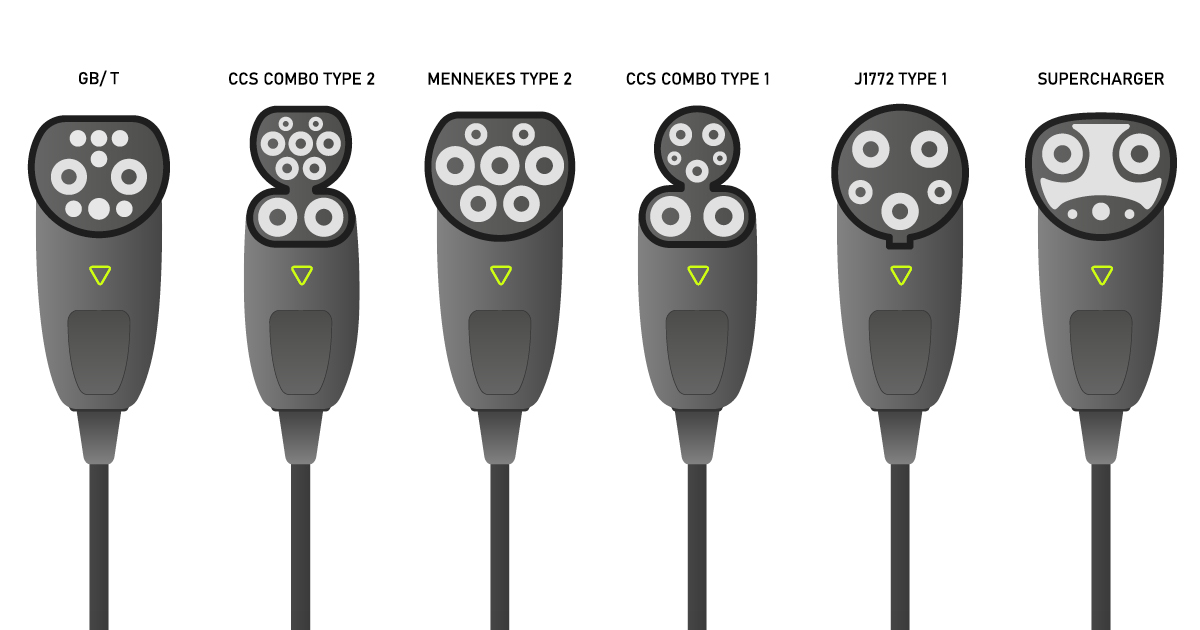The NACS Connector Revolution Explained for Instructors

As electric vehicles (EV) take hold across the world, the need for recharging them conveniently is the key to mass transition away from internal combustion engine (ICE) powered vehicles. Just like on-board diagnostics (OBD1) was back in the 1980’s and 90’s, everyone has their version of a charging standard to meet the needs of their vehicle architecture.
With these varying requirements, depending on the make and model, the customer is left trying to find a charging location to recharge their vehicle. One of the major issues with any EV application is the ability to quickly charge the vehicle when it pulls into a recharging station without extending the time it takes to refill the battery pack. The driver believes a vehicle should operate a certain way, they expect it to drive a certain way and they expect it to fill up (recharge) a certain way.
A lot of psychology goes into the design and function of the vehicles various systems to maintain a level of familiarity with the vehicle operation. To help with standardizing the charging capability and accessibility, SAE, formerly called the Society of Automotive Engineers, laid out the J1772 charging standard in 2017.
The SAE J1772 provides a standardized pin orientation and communication protocols for vehicle to charger. This standardized plug also allows original equipment manufacturers (OEM) to provide a common platform to design their PHEV/EV’s toward to make finding a recharging location easier.
The J1772 standard also defines a specific physical connector design that consists of a standardized plug and receptacle. The connector is used for both Level 1 (120-volt AC) and Level 2 (240-volt AC) charging. DC fast charging is a separate standard that must be followed to make sure the vehicle can accept that high amperage charge. In North America, this is typically the Combined Charging System (CCS) standard, which incorporates additional DC pins in the J1772 connector to support fast charging. The North American Charging Standard (NACS) utilizes the same conductor path for Level 1 and 2 along with DC fast charging. The simplicity of this connector is one of the reasons that it is being utilized in a variety of OEM’s charging protocols.

NACS and CCS Charging Standards, Explained
NACS (North American Charging Standard) and CCS (Combined Charging System) are two different connector standards for electric vehicle (EV) charging. These standards are used to ensure compatibility and interoperability between EVs and charging infrastructure. Here's an analysis of the key differences between NACS and CCS:
NACS:
NACS is primarily used in North America, including the United States and parts of Canada. This standard is built off of the Tesla’s high voltage connector that incorporates both AC and DC charging paths through two conductors. This standard for the NACS connector is SAE J3400.
This is unique to this type of connector as the CCS connector utilizes different conductors for each type of power supplied to the vehicle. The NACS connector utilizes only two conductors for both AC and DC charging. Control of the type of power provided to the vehicle is done in the main station that provides the connector power from the grid.
CCS:
CCS is a global standard used in Europe, North America, and other regions. It has gained wider adoption internationally and is promoted by several organizations, including the SAE in the US and the European Automobile Manufacturers' Association (ACEA) in Europe.
The CCS connector is often referred to as a "combo connector" because it combines the traditional J1772 AC connector with additional DC pins. This means that a single CCS connector can handle both AC charging (typically Level 2) and DC fast charging, making it versatile and capable of serving various charging needs.
A note on global variants: While the basic CCS connector design is consistent globally, there are regional variations in the maximum power levels and connector types used. For example, CCS Type 1 (often used in North America) and CCS Type 2 (common in Europe) have slightly different physical connectors but share the same underlying CCS standard for communication and DC fast charging.
Vehicle to Charger Communication
Both the CCS and NACS connectors include communication protocols that allow the EV and the charging station to communicate, ensuring safe and efficient charging processes. Controlling the amount of power provided to the vehicle helps with smoothing out the demand on the charger and the ability of the vehicle to accept the charge rate.
Just like any battery powered device, if too much power is forced into the cell the battery may overheat and fail. Most battery failures/fires are a result of thermal condition that has exceeded the ability of the cooling system to maintain the proper temperature of the cells. This communication enables features like charging rate adjustments, authentication, and billing. The ability of the vehicle to communicate with the charger also allows the charger to take control of the vehicle’s high voltage battery pack and provide a path for bi-directional electrical flow. This is known as Vehicle to Home Power Transfer.
Vehicle-to-Home Power Transfer
One benefit of charging your vehicle at your house is the ability of the vehicle to provide power to the home during a power outage. Utilizing a bi-directional charger allows the electrical grid to charge the vehicle when there is power available to charge the battery in the vehicle and then allows power to flow back to the home once grid power is no longer available.
These types of bi-directional chargers are known as Vehicle-to-home (V2H) or Vehicle-to-Grid (V2G). This alternative power supply allows your home to operate on a micro-grid and allow power input from alternative sources of power generation. This could be from solar, wind, hydroelectric or grid power. The ability to charge an electric vehicle with different types of power inputs allows the owner to utilize whichever type is near them to power their vehicle.
Integrating the vehicles’ high voltage battery pack into the electrical system of their residence allows for load shifting, which can then take advantage of lower cost times of the day to charge their vehicle. This smart technology provides the owner with the lowest possible cost to recharge their vehicle.
What is the Future of EV Charging Standards?
EV charging standards will continue to evolve relying on the demand from the consumer for the vehicle to become a larger part of their life. With major OEM’s such as Ford, Volvo, GM, Hyundai, Polster, Rivian, and a host of others, wanting to get access to the large charging network Tesla has developed, they have adopted the NACS to allow their future vehicles to connect directly to the chargers. This larger networking relationship will also gain the OEM’s (Tesla in particular) a greater piece of the daily recharging fees that are associated with operating the vehicle after the sale.
Access to a fast charger network or utilizing the high voltage battery pack as a micro-grid would help the owner of the vehicle utilize the vehicle in a larger part of their daily life. With this increased complexity, the technician must be able to move from one type of system to another with a thorough understanding of how these systems interoperate with each other.
CDX Learning systems is constantly developing new content, ways to disseminate that content and constantly reevaluating what is the current product offering to make sure it is meeting the needs of the changing landscape in the automotive and diesel training environment.
With the advent of electric vehicle technologies starting to become a larger part of the automotive market, CDX has adjusted its content to meet the need. CDX has a commitment to making sure instructors and students have the relevant training material to further hone their skill sets within the mechanical and electrical trade. The Light Duty Hybrid and Electric Vehicles title is one of many offered by CDX Learning Systems, that brings cutting edge technologies into the classroom to keep you up to date on what is currently happening within the mobility industry.
CDX Learning Systems is constantly developing new content, ways to disseminate that content and constantly reevaluating what is the current product offering to make sure it is meeting the needs of the changing landscape in the automotive and diesel training environment.
CDX has a commitment to making sure instructors and students have the relevant training material to further hone their skill sets within the automotive trade. The Light Duty Hybrid and Electric Vehicles title brings this and other technologies into the classroom to keep you up to date on what is currently happening in the mobility industry.
Related Content:
- Near Field Communication is Disrupting the Auto Industry. Here’s How Automotive Instructors Should Adjust Their Teaching
- Wireless EV Charging: Transforming the Future of Electric Vehicles
- The Hydrogen Fuel Cell Mass Adoption Myth: Should We Teach Hydrogen Fuel Cell Technology to Automotive Students?
About the Author:
Nicholas Goodnight, PhD is an ASE Master Certified Automotive and Truck Technician and an Instructor at Ivy Tech Community College. With nearly 20 years of industry experience, he brings his passion and expertise to teaching college students the workplace skills they need on the job. For the last several years, Dr. Goodnight has taught in his local community of Fort Wayne and enjoys helping others succeed in their desire to become automotive technicians.